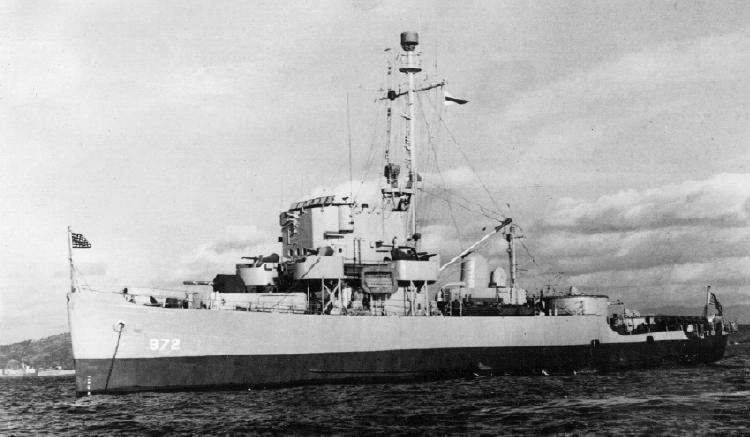Built 1942–1945 | Completed 68 | |
 | ||
Builders Pullman Standard Car, ChicagoAlbina, PortlandWillamette Iron & Steel Operators United States Navy United States Coast Guard Royal Navy Republic of Korea Navy Mexican Navy Ecuadorian Navy Colombian National Navy Republic of Vietnam Navy Republic of China Navy Cuban Navy Philippine Navy Myanmar Navy Length 180 ft (54.86 m) wl184 ft 6 in (56.24 m) oa | ||
The Patrol Craft Escort was a World War II naval ship that was intended as a coastal and convoy escort. It was derived from the 180 foot Admirable-class minesweeper as a substitute for the 173 foot PC-461-class submarine chaser that was used for Anti-submarine warfare (ASW) in coastal areas. At 185 feet long and 640 tons, the PCE is more than twice the displacement of the PC. It has a crew complement of 99 officers and men.
Contents
Development and design
The Admirable class had been developed as a smaller minesweeper than the Raven-class and Auk-class minesweepers, which would be cheaper and easier to build, while still having good seakeeping capabilities in high seas. An escort derivative of the new design was proposed for supply under the Lend-Lease scheme to Britain's Royal Navy (which had already rejected the Admirable -class as minesweepers), and when the US Navy realized that a shortage of engines might prevent it from receiving additional PC-461-class submarine chaser beyond those already on order, it was decided to build the escort variant, designated as PCEs (Patrol Craft Escort) for both the US Navy and Royal Navy.
Engines
The PCE has two 1,000 HP diesel engines driving two shafts and two propellers giving it a 16 knots maximum sustained speed and a range of 8,000 miles at cruising speed of 13 knots.
Armaments
The usual PCE armaments are a dual-purpose 3"/50 cannon, three 40mm Anti-Aircraft guns, four 20mm guns, and two depth charge tracks. Some were later fitted with torpedoes, rockets, hedge hogs, and Heavy Machine Guns.
Detection equipment
The PCE was fitted with radar, and sonar and other detection equipment for Anti-Submarine Warfare (ASW).
Conversions
Some PCEs later were converted to PCE(R), Rescue Escorts, and to Amphibious Control Vessels, PCE(C)that were used in many U.S. amphibious landing operations in World War II specially Leyte Gulf and Normandy.
Production
Sixty Eight (68) Patrol Craft Escorts were built for the US Navy, and seventeen (17) were delivered under the Lend-Lease Program to Allies during World War II. The PCEs proved to be an inexpensive substitute for larger and more valuable DD's and DE's in convoy escort work.
Philippine Navy
In 2014, the Philippine Navy still operates the Miguel Malvar class with six PCE's as gun corvettes, with all the ships' ASW equipment already removed. The PCE is the most numerous major ship class of the Philippine Navy that, at one time, numbered more than ten vessels.
